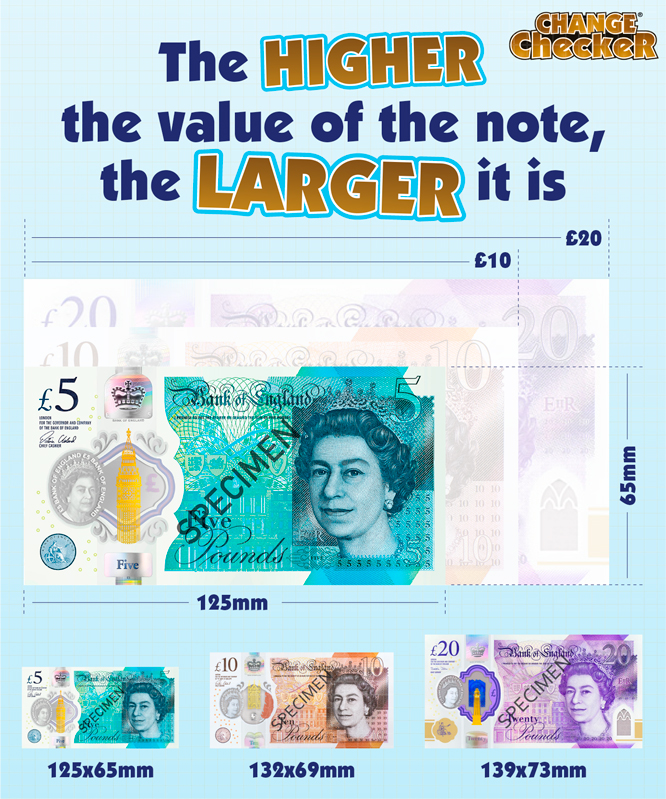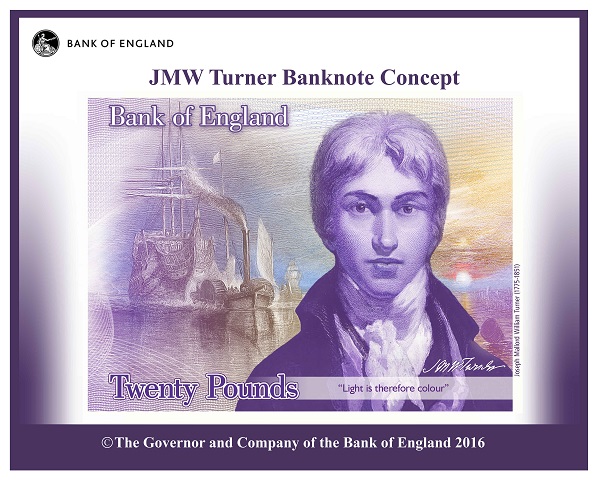Posts Tagged ‘polymer’
How to spot a counterfeit banknote!
In 1725, printed banknotes were first introduced in the UK, with the purpose of fixed denominations. The £20 banknote came first and following a shortage of metallic currency during the Seven Years’ War in 1759, £10 and £15 notes were issued.
The £5 note was the last to be introduced in 1793. But since their introduction, banknotes have been subject to fraudulent behaviour, so much so, additional banknotes have been executed partly to make forgery of such more difficult.
Fraudulent notes are also called ‘counterfeit banknotes’ and although less and less are going into circulation — with less than 1 in 40,000 banknotes being counterfeit in 2021 — it’s still an important topic to discuss!
Although polymer banknotes are a lot harder to replicate than the traditional paper ones, you should still check your notes when you receive them. But the questions is, how do you spot a counterfeit banknote?
Sizing
For every polymer banknote, a good starting point is to look at its size.
The higher the value, the larger it is. Here we can see the approximate sizes of the £5, £10 and £20 polymer banknotes:

Security Features
Crucially, you should always check your polymer banknotes for the following key security features:

Changing hologram:
- All polymer notes when tilted from side to side and up and down, should feature word changes within their holograms.
- For the £5 banknote, the words should change between ‘Five’ and ‘Pounds’, the £10 banknote between ‘Ten’ and ‘Pounds’ and so on.
See-through windows:
- Each banknote of denomination has a metallic image over the see-through window on it.
- Both the £5 and £10 polymer notes have gold foil on the front of the note within this part and silver on the back.
- The £20 note has a blue and gold foil on the front of the note for the metallic image and silver on the back.
- Lastly, the £50 note has gold and green foil on the front and silver on the back.
Feel of polymer and raised print:
- Polymer is a thin and flexible material so check that the material of your banknote feels this way.
- On each denomination banknote as well, the words ‘Bank of England’ should feel raised.
Foil patches:
- Each banknote denomination will have a different foil patch on it.
- For the £5 note, this is a green foil patch — it is circular and spells ‘BLENHEIM’ to commemorate where Churchill was born.
- The £10 note has a copper foil patch, and this is shaped as a book.
- Check it contains the letters ‘JA’, in tribute to Jane Austen.
- A purple foil patch shaped in a circle with a ‘T’ at its centre, to represent JMW Turner, is imprinted on the £20 note and lastly, a metallic red foil patch can be found on the £50 note and contains the letters ‘AT’ for Alan Turing.
- The patches can all be located behind the silver crown on the front of the notes.
The queen’s portrait in the see-through window:
- The Queen’s portrait which is printed within the see-through window can be found on all the banknotes with the respective denomination and the words ‘Bank of England’ printed twice.
- For example, on the £5 note the inscription ‘£5 Bank of England’ will be printed twice around the windows edge.
This is a just a small selection of the security features that you can find on your polymer banknote. Can you name some of the other features? Let us know in the comments below!
Counterfeit banknotes have no monetary value and cannot be reimbursed. The best thing to do if you encounter a counterfeit banknote is take it to your nearest police station.
They will ask you to fill out a form and once taken from you, will send the suspect note(s) to the National Crime Agency and if found to be counterfeit, to the Bank of England for further examination.
If you’re interested in coin collecting, our Change Checker web app is completely free to use and allows users to:
– Find and identify the coins in their pocket
– Collect and track the coins they have
– Swap their spare coins with other Change Checkers
Sign up today at: www.changechecker.org/app
Who would you like to see on the new polymer £50 note?
This weekend, the Bank of England confirmed that the £50 note will remain part of UK currency and a new batch will be issued after the £20 note in 2020 following a public nomination process to select potential characters to appear on it.
In keeping with the new £5 and £10 polymer notes, the £50 will also be printed on thin, flexible plastic polymer material, making them cleaner, safer and stronger.
In September 2016, the first polymer £5 note featuring Winston Churchill entered circulation in the UK. Its success lead to the Jane Austen £10 polymer note being released the following year and plans for the first polymer £20 note featuring artist JMW Turner to be issued in 2020. It will be down to the public to decide who should appear on the new £50 notes, so who would you nominate?

£20 concept image. Credit: Bank of England.
The £50 note was first introduced in 1981 and there are now 330 million in circulation, totalling a combined value of £16.5 billion!
Recently there have been fears that £50 notes are being used for criminal activity such as tax evasion and are rarely used for standard purchases. However, the Treasury has said that this new batch of polymer notes has been designed to be more secure and harder to forge, meaning that they are here to stay.

2011 £50 note. Credit: Bank of England.
They will also be more durable and environmentally friendly than their predecessors, lasting roughly 2.5 times longer than paper notes.
Sarah John, the Bank’s Chief Cashier, said: “I’m very excited to be starting the process of introducing a new £50 note. At the Bank, we are committed to providing the public with high quality notes they can use with confidence. Moving the £50 note onto polymer is an important next step to ensure that we can continue to do that.”
What are your thoughts on the £50 note and who would you like to see feature on the next polymer batch? Let us know in the comments below!
If you’re interested in coin collecting, our Change Checker web app is completely free to use and allows users to:
– Find and identify the coins in their pocket
– Collect and track the coins they have
– Swap their spare coins with other Change Checkers

Sign up today at: www.changechecker.org/app
Here’s where you can find the new Jane Austen Polymer £10 note…
LEEDS
HSBC: 33 Park Row, LS1 1LD
YORKSHIRE BANK: 94-96 Briggate, LS1 6NP
CARDTRONICS: Rawdon Newsagents, 11 Harrogate Road, LS19 6HW
LIVERPOOL
SANTANDER: 45 Lord Street, L2 6PB
NEWCASTLE
SANTANDER: 112-118 Northumberland Street, NE1 7DG
BIRMINGHAM
HSBC: 130 New Street, B2 4JU
NATWEST: Grand Central, B2 4BF
LLOYDS: 36-38 New Street, B2 4EG
BARCLAYS: 79-84 High Street, B4 7TE
MANCHESTER
NOTE MACHINE: Lowry Outlet Mall, The Quays, Salford, M50 3AP
NATWEST: 1 Spinningfields, M3 3AP
BARCLAYS: 17 St Ann’s Square, M2 7PW
LONDON
NOTE MACHINE: Barry’s Food and Wine, 149 Hoxton Street, N1 6PJ
SANTANDER: 48-54 Moorgate, EC2R 6EJ & 164-167 Tottenham Court Road, W1T 7JE & 2 Triton Square, Regents Place, NW1 3AN
POST OFFICE: 26/28 The Broadway, E15 4QS
BARCLAYS: 46-48 Regent Street, Piccadilly, W18 5RA
HSBC: 165 Fleet Street, EC4A 2DY
NATIONWIDE: 1 Threadneedle Street, EC2r 8BP
NATWEST: 10 Southwark Street, SE1 1TJ
LLOYDS: 33 Old Broad Street, EC2N 1HZ
BASINGSTOKE
NATWEST: 3 London Street, RG21 7NS
WINCHESTER
SANTANDER: 119 High Street, SO23 9AS
NATWEST: 105 High Street, SO23 9AW
BATH
NOTE MACHINE : Eurochange Bath, 6 Southgate Street
HSBC: 45 Milsom Street, BA1 1DU
NATWEST: 15-17 High Street, BA1 5AH
CARDIFF
LLOYDS: 31 Queens Street, CF10 2AG
SWINDON
NATIONWIDE: Nationwide House, Pipers Way, SN3 1TX

